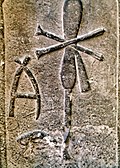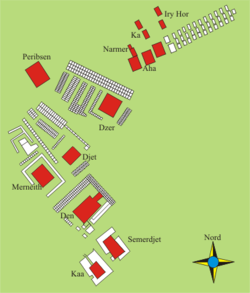Merneith
| Merneith | |
|---|---|
 Tomb stela of Merneith from theUmm el-Qa'ab. | |
| RegentofEgypt | |
| Reign | ca. 2950 BC[1] |
| Co-monarch | Den |
| Burial | Tomb Y,Umm El Qa'ab |
| Spouse | Djet |
| Issue | Den |
| Dynasty | 1st Dynasty |
| Father | Djer? |
Merneith(also writtenMerit-neithandMeryt-Neith) was aconsortand aregentofAncient Egyptduring theFirst Dynasty.[2]She may have been a ruler of Egypt in her own right, based on several official records.[3][4]If this was the case and the earlier royal wifeNeithhotepnever ruled as an independent regent, Merneith may have been the first femalepharaohand the earliestqueen regnantinrecorded history.Her rule occurred around 2950 BC[1]for an undetermined period. Merneith’s name means "Beloved byNeith"and herstelecontains symbols of thatancient Egyptian deity.She may have beenDjer's daughter and was probablyDjet's senior royal wife.[5]The former meant that she would have been the great-granddaughter of unified Egypt's first pharaoh,Narmer.She was also the mother ofDen,[6]her successor.[7]
Family[edit]
Merneith is linked with the kings Djer, Djet and Den in a variety of seal impressions and inscribed bowls. Merneith may have been the daughter of Djer, but there is no conclusive evidence. As the mother of Den, it is likely that Merneith was the wife of Djet. No information about the identity of her mother has been found.[8][9]
A claysealfound in the tomb of her son, Den, was engraved with "King's Mother, Merneith".[6]It also is known that Den’s father was Djet,[where?]making it likely that Merneith was Djet’s royal wife.
From Abydos comes a small ivory fragment with the remains of two figures. It is possible that they show Merneith together with her son king Den.[10]
Biography[edit]
Merneith is believed to have become ruler upon the death ofDjet.The title she held, however, is debated. It is possible that her son Den was too young to rule when Djet died, so she may have ruled as regent until Den was old enough to be the king in his own right. Before her,Neithhotepis believed to have ruled in the same way after her husbandKing Narmerdied, as Narmer's son was too young to rule. Her name was written on a Naqada seal inside a serekh, which was the way the kings' names were written. This would mean Merneith may have actually been the second female in Egypt's first dynasty to have ruled as pharaoh.
The strongest evidence that Merneith was a ruler of Egypt is her tomb. This tomb inAbydos(Tomb Y) is unique among the otherwise exclusively male tombs. Merneith was buried close to Djet and Den. Her tomb is of the same scale as the tombs of the kings of that period. Two grave stelae bearing her name were discovered near her tomb. Merneith's name is not included in the king lists from theNew Kingdom.A seal containing a list of pharaohs of the first dynasty was found in the tomb ofQa'a,the third known pharaoh afterDen,her son. However, this list does not mention the reign of Merneith.[9]
A few other pieces of evidence exist elsewhere about Merneith:
- Merneith’s name appears on aseal found in the tomb of her son, Den.The seal includes Merneith on a list of the first dynasty kings. Merneith's name was the only name of a woman included on the list. All of the names on the list are theHorus namesof the kings. However, Merneith's name is accompanied by the title "King's Mother".
- Merneith’s name may have been included on thePalermo Stone.[9]
- Items from the greatmastaba(Nr 3503, 16 x 42 m) inSaqqara,where her name has been found in inscriptions on stone vessels, jars, as well as seal impressions. In particular, there is one seal from Saqqara, which shows Merneith's name in aserekh.[9]
- The so-called Merneith Enclosure is a group of tombs from the cemetery at Shunet el-Zebib. These tombs are dated to the time of Merneith.[11]
- Merneith's name was found on objects in kingDjer's tomb in Umm el-Qa'ab.
Tombs at Abydos and Saqqara[edit]


AtAbydos,the tomb belonging to Merneith was found in an area associated with other pharaohs of the first dynasty,Umm el-Qa'ab.Twostelaemade of stone, identifying the tomb as hers, were found at the site.
In 1900Flinders Petriediscovered Merneith’s tomb and, because of its nature, believed it belonged to a previously unknown pharaoh. The tomb was excavated and was shown to contain a large underground chamber, lined with mud bricks, which was surrounded by rows of small satellite burials, with at least 40 subsidiary graves for servants.[9][12]
The servants were thought to assist the ruler in the afterlife. The burial of servants with a ruler was a consistent practice in the tombs of the early first dynasty pharaohs. Large numbers of sacrificial assets were buried in her tomb complex as well, which is another honor afforded to pharaohs that provided the ruler with powerful animals for eternal life. This first dynasty burial complex was very important in the Egyptian religious tradition and its importance grew as the culture endured.
Inside her tomb archaeologists discovered afunerary boat[13]that would allow her to travel with the sun deity in the afterlife.
Abydos was the site of many ancient temples, including Umm el-Qa'ab, the royal necropolis, where early pharaohs were entombed.[14]These tombs began to be seen as extremely significant burials and in later times it became desirable to be buried in the area, leading to the growth of the town's importance as a cult site.
AtSaqqara,Merneith's tomb exhibits features that possibly preview the builders of the Third Dynasty. Concealed within the normal rectangular palace façademastabaof Merneith's tomb at Saqqara is the base of a stepped structure, a juxtaposition of two different methods of building. It is perhaps indicative of the fusion of northern and southern styles that was to lead, ultimately, to theStep Pyramidof Djoser, or influenced the design of the Third Dynasty structure.[15]
References[edit]
- ^abTeeter, Emily (ed.).Before the Pyramids, The Origins of Egyptian Civilization.The Oriental Institute of the University of Chicago, 2011, p. 207
- ^Vanhulle, Dorian (2023-11-14)."Boat Burials and Boat-Shaped Pits from their Origins to the Old Kingdom: Tradition, Continuity and Change in Early Egypt".International Journal of Nautical Archaeology:1–19.doi:10.1080/10572414.2023.2264551.ISSN1057-2414.S2CID265239069.
- ^Dee, Michael; Wengrow, David; Shortland, Andrew; Stevenson, Alice; Brock, Fiona; Girdland Flink, Linus; Bronk Ramsey, Christopher (2013-11-08)."An absolute chronology for early Egypt using radiocarbon dating and Bayesian statistical modelling".Proceedings of the Royal Society A: Mathematical, Physical and Engineering Sciences.469(2159): 20130395.Bibcode:2013RSPSA.46930395D.doi:10.1098/rspa.2013.0395.ISSN1364-5021.PMC3780825.PMID24204188.
- ^Allen, Troy D. (July 2008)."Cheikh Anta Diop's Two Cradle Theory: Revisited".Journal of Black Studies.38(6): 813–829.doi:10.1177/0021934706290354.ISSN0021-9347.S2CID144524456.
- ^Bagnall, Roger S.; Brodersen, Kai; Champion, Craige B.; Erskine, Andrew; Huebner, Sabine R., eds. (2013-01-30).The Encyclopedia of Ancient History(1 ed.). Wiley.doi:10.1002/9781444338386.wbeah15112.ISBN978-1-4051-7935-5.
- ^abWilkinson, Toby A.H.Early dynastic EgyptRoutledge; 1 edition (14 Jun 2001)ISBN978-0-415-26011-4p.74[1]
- ^Griffin, Ken (2008)."Current Research in Egyptology 2007: Proceedings of the Eighth Annual Conference":1–158.
{{cite journal}}:Cite journal requires|journal=(help) - ^Aidan Dodson & Dyan Hilton:The Complete Royal Families of Ancient Egypt.Thames & Hudson, 2004,ISBN0-500-05128-3,p.140
- ^abcdeJ. Tyldesley, Chronicle of the Queens of Egypt, 2006, Thames & Hudson
- ^Matthieu BégonːUne probable représentation de la reine Meret-Neith en tant que régente du roi Den,in̊ːENiM13, 2020, p. 211-215
- ^Porter and MossTopographical Bibliography; Volume V Upper EgyptGriffith Institute. p.55
- ^[2]Tomb of Merneith at Abydos
- ^Egypt solar boats
- ^"Tombs of kings of the First and Second Dynasty".Digital Egypt.UCL.Retrieved2008-01-15.
- ^A., Clayton, Peter (1994).Chronicle of the Pharaohs: the reign-by-reign record of the rulers and dynasties of ancient Egypt.New York, N.Y. pp.24-25.ISBN0500050740.OCLC31639364.
{{cite book}}:CS1 maint: location missing publisher (link) CS1 maint: multiple names: authors list (link)
External links[edit]
- Archaeologists discover 5,000-year-old wine at the tomb of Meret-Neith in Abydos - phys.org - October 9, 2023
- Wine jars from her grave from Abydos.

